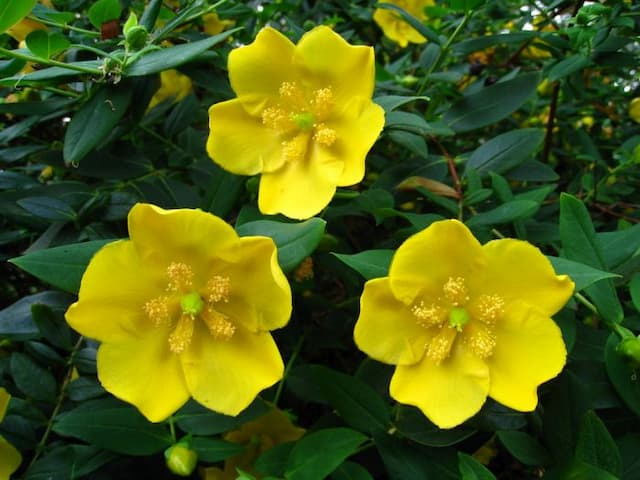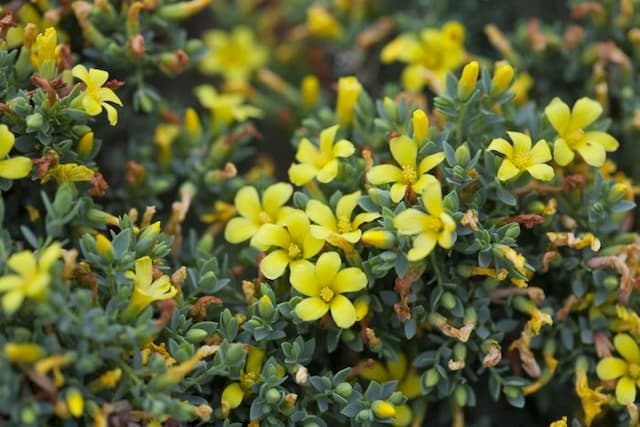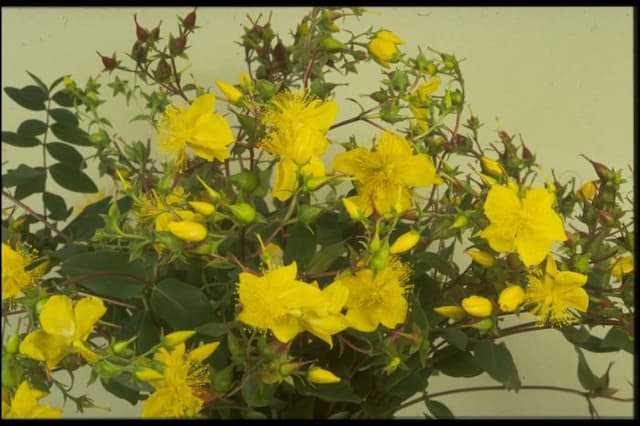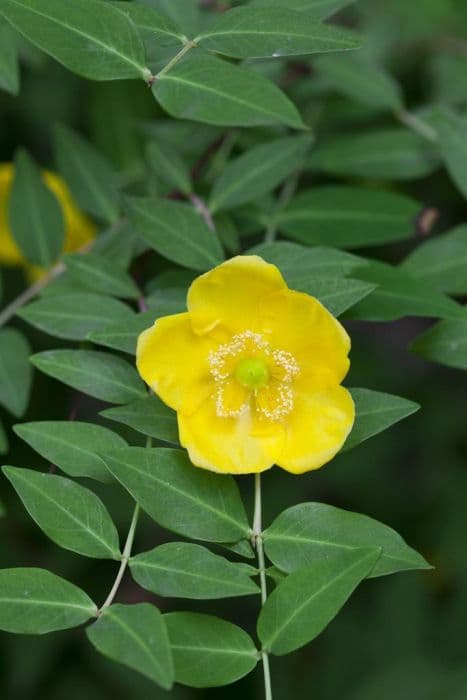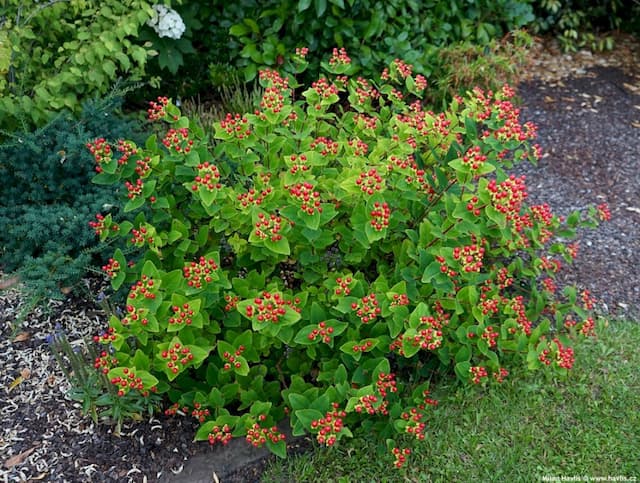Tricolor St. John's Wort Hypericum × moserianum 'Tricolor' (v)

ABOUT
Hypericum × moserianum 'Tricolor', commonly known as Tricolor St. John's Wort, is a visually striking plant noted for its decorative qualities. This plant boasts a multicolored foliage where each leaf presents a blend of colors. The leaves are primarily green, but they are splashed with shades of creamy yellow and pink, which create a variegated pattern. This tricolor effect adds a vibrant contrast and visual interest to garden spaces. During the blooming period, Tricolor St. John's Wort produces bright yellow flowers that are rich in color and have a conspicuous, bushy appearance. These flowers consist of numerous stamens that emerge prominently from the center, creating a frilly, ornamental look. The bright flowers against the tricolor leaves create a lively and colorful display. The branches of Tricolor St. John's Wort are slender and may arch gracefully, giving the plant a somewhat sprawling form. The overall appearance of the plant is one of cheerful vibrancy, thanks to the combination of its variegated foliage and eye-catching flowers. With its unique coloration, this plant adds a splash of color to gardens and can serve as an attractive focal point or accent plant.
About this plant
 Names
NamesFamily
Hypericaceae
Synonyms
Tricolor St. John's Wort, Variegated St. John's Wort
Common names
Hypericum × moserianum 'Tricolor' (v).
 Toxicity
ToxicityTo humans
The St John's Wort is not considered highly toxic to humans. Ingestion of this plant in small quantities is unlikely to cause serious problems, but it may cause some gastrointestinal irritation, including nausea and diarrhea in some individuals. While the ingestion of significant amounts could potentially lead to more severe reactions, such cases are rare. It is always recommended to exercise caution and avoid eating plants that are not confirmed to be safe for consumption.
To pets
The St John's Wort can be toxic to pets, particularly cats and dogs, if ingested. The symptoms of toxicity in pets can include gastrointestinal upset, such as vomiting and diarrhea. Additionally, in more severe cases, muscular weakness, lethargy, and symptoms of nervous system depression may be observed. If you suspect your pet has ingested this plant, it is best to consult a veterinarian.
 Characteristics
CharacteristicsLife cycle
Perennials
Foliage type
Semi-deciduous
Color of leaves
Mixed
Flower color
Yellow
Height
1-3 feet (30-91 cm)
Spread
1-4 feet (30-122 cm)
Plant type
Shrub
Hardiness zones
5-9
Native area
Cultivar
Benefits
 General Benefits
General Benefits- Attractive Foliage: The 'Tricolor' variety of Hypericum, commonly known as Tricolor St. John's Wort, has variegated leaves that add visual interest to garden spaces.
- Blooms in Summer: Tricolor St. John's Wort produces bright yellow flowers that are especially appreciated during the summertime.
- Low Maintenance: This plant is known for being hardy and requiring minimal maintenance, making it a good choice for gardeners of all levels.
- Drought Tolerance: Once established, Tricolor St. John's Wort is tolerant of drought, reducing the need for frequent watering.
- Wildlife Attraction: Its flowers are attractive to bees and other pollinators, enhancing biodiversity in the garden.
- Ground Cover: With its dense and spreading habit, it can serve as an effective ground cover, suppressing weeds and stabilizing soil.
- Seasonal Interest: Tricolor St. John's Wort offers multiple seasons of interest with its changing leaf colors and flowering cycle.
- Semi-Evergreen: In milder climates, this plant retains its leaves throughout much of the year, providing consistent foliage.
 Medical Properties
Medical PropertiesThis plant is not used for medical purposes.
 Air-purifying Qualities
Air-purifying QualitiesThis plant is not specifically known for air purifying qualities.
 Other Uses
Other Uses- Photography Backdrops: With its unique foliage, the Tricolor St. John's Wort can serve as an attractive, subtle backdrop for product or macro photography sessions.
- Craft Projects: The variegated leaves can be pressed and used in craft projects such as handmade cards or botanical prints.
- Education: Tricolor St. John's Wort can be a great specimen in educational settings to teach about variegation and hybridization in plants.
- Floating Decorations: Leaves and flowers can float on water in decorative bowls for a natural touch to table settings during events or gatherings.
- Eco-Friendly Confetti: Dried petals of Tricolor St. John's Wort can be used as a biodegradable confetti alternative for celebrations.
- Plant Dye: The leaves and flowers may be used to create natural dyes for fabrics or paper, adding a subtle range of colors.
- Nature-Inspired Art: Artists can use parts of the plant to create nature-inspired art pieces or to add texture and color to mixed media art.
- Bookmarks: Pressed leaves and flowers from the Tricolor St. John's Wort can be laminated to create unique and personalized bookmarks.
- Garden Photography: As a unique garden variety, this plant provides excellent subject matter for hobbyist and professional garden photographers.
- Bath Infusions: The flowers and leaves, while not medically beneficial, can still add a soothing aroma and aesthetic to bathwater when used in homemade bath infusions.
Interesting Facts
 Feng Shui
Feng ShuiThe St. John's Wort is not used in Feng Shui practice.
 Zodiac Sign Compitability
Zodiac Sign CompitabilityThe St. John's Wort is not used in astrology practice.
 Plant Symbolism
Plant Symbolism- Protection: Hypericum, also known as St. John's Wort, has been associated with warding off evil spirits and protective qualities, particularly in European folklore.
- Healing: Traditionally known for its medicinal properties, especially in herbal medicine, St. John's Wort symbolizes health and the power to heal physical and emotional wounds.
- Strength: The hardy nature of St. John's Wort, being able to thrive in various conditions, stands for resilience and the ability to withstand challenges.
- Happiness: Its use in treating depression and uplifting mood in herbal medicine makes St. John's Wort represent joy, well-being, and the pursuit of positive mental states.
- Midsummer Celebration: The plant blooms around the time of Midsummer and is often used in festivals; it symbolizes the peak of summer and the celebration of light and abundance.
 Water
WaterThe Tricolor St. John's Wort should be watered when the top inch of soil feels dry to the touch, which typically amounts to watering once a week. During the growing season, it may require more frequent watering, especially if conditions are hot and dry. Use a watering can or a hose with a gentle shower attachment to moisten the soil evenly without soaking it. A good guideline is to provide about 1 gallon of water per week, ensuring it reaches the root zone. During winter, reduce watering to every other week or less, depending on the plant's environment and the soil moisture level.
 Light
LightTricolor St. John's Wort thrives in full sun to partial shade. The ideal spot would receive at least 6 hours of direct sunlight daily while being protected from the harsh afternoon sun, which could cause leaf scorch. Morning sunlight with dappled or partial shade in the afternoon is optimal for promoting healthy growth and vibrant foliage colors.
 Temperature
TemperatureTricolor St. John's Wort is hardy and can tolerate a temperature range from about 50 to 90 degrees Fahrenheit. The plant's ideal temperature conditions for vigorous growth are between 60 and 80 degrees Fahrenheit. While it can survive slight dips below 50 degrees Fahrenheit, prolonged exposure to freezing temperatures should be avoided to prevent damage to the plant.
 Pruning
PruningPruning Tricolor St. John's Wort is important for maintaining shape and encouraging new growth. Trim back the plant in late winter or early spring before the onset of new growth. This helps to remove any dead or damaged branches and allows light to penetrate, promoting a bushier growth habit. Pruning can also rejuvenate older plants, allowing them to produce more flowers. It is often sufficient to prune once a year, but deadheading spent flowers throughout the growing season can encourage additional blooming.
 Cleaning
CleaningAs needed
 Soil
SoilThe Tricolor St. John's Wort prefers well-draining soil with a slightly acidic to neutral pH, typically around 6.0 to 7.0. An ideal soil mix could be composed of two parts loam, one part peat moss, and one part sand or perlite to ensure proper drainage. Ensuring organic matter in the soil will help retain moisture while providing good aeration and nutrients.
 Repotting
RepottingTricolor St. John's Wort should be repotted every 2-3 years or when it has outgrown its current pot. The best time for repotting is in the spring as the plant resumes active growth, which allows it to recover and establish itself more easily in the new soil and container.
 Humidity & Misting
Humidity & MistingTricolor St. John's Wort does not have specific humidity requirements and can tolerate a range of conditions, but it does well in moderate humidity. Avoid extremely dry conditions to prevent desiccation, especially during hot, dry summers.
 Suitable locations
Suitable locationsIndoor
Provide bright indirect sunlight and water when topsoil is dry.
Outdoor
Plant in well-draining soil, full sun to partial shade.
Hardiness zone
5-9 USDA
 Life cycle
Life cycleHypericum × moserianum 'Tricolor' commonly known as Tricolor St. John's Wort, begins its life cycle as a seed, which will germinate under the right conditions of warmth and moisture, usually in spring. Once germinated, the seedling emerges and starts to develop roots and shoots. As the plant grows, it forms distinctive variegated leaves of green, pink, and cream, and in the summer, it enters the flowering stage, producing yellow blossoms that are attractive to various pollinators. After pollination, the flowers develop into small capsules containing numerous tiny seeds, which will mature and be dispersed in late summer or autumn, enabling the spread of the species. In colder climates, Tricolor St. John's Wort behaves as a herbaceous perennial, dying back to the ground after frosts but regrowing from the root system in the spring. This cycle of growth, bloom, seed production, and dormancy continues annually, with proper care and favorable conditions ensuring the plant's survival and spread.
 Propogation
PropogationPropogation time
Spring-Early Summer
The St. John's Wort 'Tricolor', known botanically as Hypericum × moserianum 'Tricolor', is often propagated by taking semi-hardwood cuttings during the summer months when the plant is actively growing. To propagate using this method, a gardener should select a healthy, non-flowering stem and cut a 4-6 inch (approximately 10-15 cm) section, making sure that several leaves are present. The lower leaves should be removed, and the cut end can be dipped in rooting hormone powder to encourage root development. The cutting should then be planted in a well-draining potting mix, ensuring that at least one node, the part of the stem where leaves emerge, is buried beneath the soil surface. The pot should be kept in a warm area with indirect light and maintained moist until the cutting has rooted, which is usually indicated by new growth.
